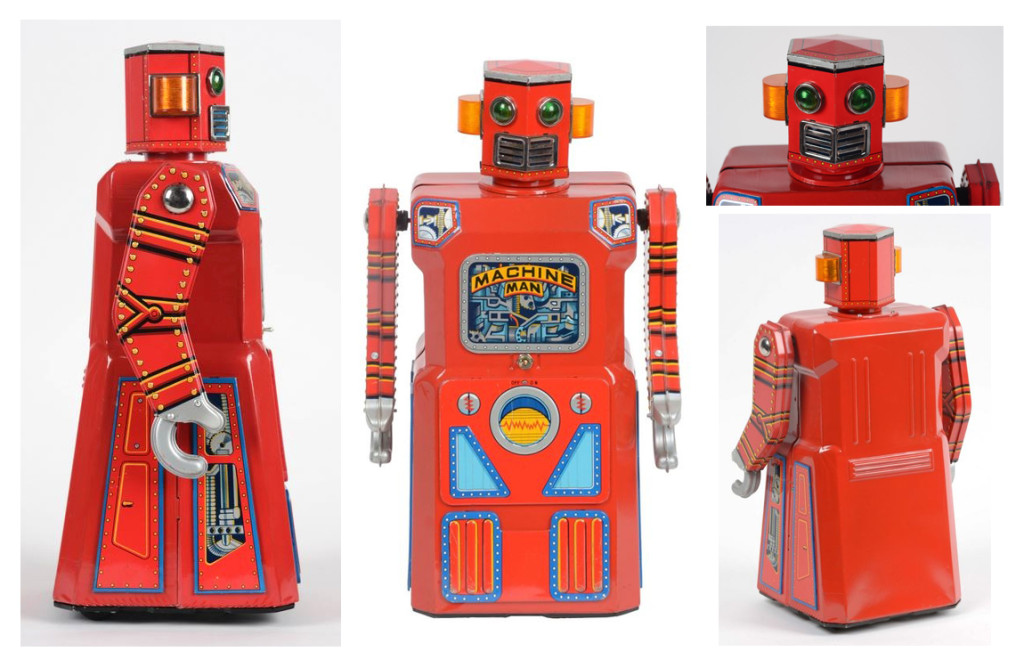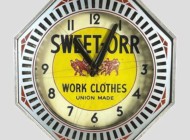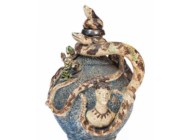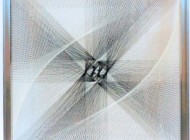
The sale’s top lot was a Machine Man robot from Japanese maker Masudaya’s Gang of 5 series. The robot sold for $86,100, an auction record any unboxed robot. The Machine Man is the scarcest of all Japanese tin litho robots and represents the apex of the genre. The example had been in the original owner’s collection since he was nine years old, having received it as a gift. The new owner now has a complete Gang of 5 series, one of only a handful in the world.
Review and Onsite Photos by Greg Smith
DENVER, PENN. – Nearly 1,600 lots crossed the block in Morphy’s twice annual Toy, Doll & Figural Cast Iron sale March 13-14. The sale offered collectors a fine assortment of cast iron mechanical banks, doorstops and toys as well as early glass marbles, dolls, board games, tin litho toys from German and Japanese makers, robots, American and European trains, sports memorabilia, pressed steel cars, automata and more.
At the end of the two-day auction, the total sales gross fell right between the $1.5/2.5 million estimate to total $2 million with a 97 percent sell through rate.
Tom Sage Jr, head of the toy and train division, saw plenty of strengths within the sale that amounted to a successful run. “It was one of the best toy sales we’ve had in the last few years,” he said. “It had fresh collections and very diverse sales. I’m extremely happy with it, as is Dan Morphy.”
At the top of the sale was an auction record for an unboxed robot as the genre’s apex model Machine Man, a tin-lithographed robot from Japanese maker Masudaya, sold at $86,100. Machine Man is the scarcest member of Masudaya’s Gang of 5 series, a group of skirted mechanical and battery-operated tin-lithographed robots that were produced in the 1950s and 1960s. The Machine Man was an anomaly among the group, made for a US importer and never appearing in the manufacturers catalog like the others. The example at hand is one of the finest known: fully functional and graded in mint-near mint condition.
The robot came to sale from its original owner, who had received it as a Christmas gift when he was nine years old. The box was not with the example when he received it.
In his decades of handling toys, Sage Jr has only handled one other Machine Man. “I’ve been buying robots since the 70s, and it’s only the second one I’ve had, while I’ve had maybe ten of each of the others,” he said.
According to Sage Jr, the collector who purchased the example is now one of the few people in the world who owns the complete Gang of 5 series.
-1024x935.jpg)
Left, Jay Lowe, the head of Morphy’s doll division, and Tom Sage Jr, right, head of Morphy’s toy and train division, stand together following the first day of the sale.
At $8,320 was another rare robot, the Tetsujin No. 1 with rubber hands by Nomura, in working condition and original box. It was followed by a Changeman robot by Horikawa, one of only 20 made, that sold for $5,120. The battery-operated Changeman would morph, his reptilian head splitting in two and an astronaut’s head rising up from the body to take control.
“It’s a strong market,” Sage Jr said, referring to early robot toys. “There’s a lot of younger people in that. It’s got a good future in it. And if we do any more space exploration, that always adds a little kick to it.”
Among materials, cast iron dominated the sale in terms of gross revenue. American cast iron mechanical banks with impeccable paint and condition by both Kyser & Rex and J&E Stevens came to the forefront. The collection hailed from an unnamed single owner.
With Don Markey provenance, a Kyser & Rex Merry-Go-Round mechanical bank was the second highest lot in the sale and the top lot of its category at $55,350. It was listed in near mint condition and sold to a phone bidder. That same bidder would bring home the next top mechanical bank as well, a J&E Stevens Milking Cow in mint condition with provenance from the Hegarty collection. Listed as one of the best examples known, it sold for $49,200.
Like many other markets, condition is king among toys, and Sage Jr sees pristine examples bringing higher prices each time they are offered.
“Things that are 95 percent or better, they are seeing exponential growth,” he said. “I’ve noticed it happening more in that past five years… every auction, there are four or five great pieces, and everyone focuses on those. So they bring great prices and drive the value higher.”
-999x1024.jpg)
The highest selling mechanical bank in the sale, this near-mint condition Merry-Go-Round bank by Kyser & Rex would bring $55,350 to a phone bidder.
A slew of J&E Stevens banks would form a team of top earners. At $48,000 was a Magician bank with original box. It was in near mint plus condition and was also listed as one of the finest examples known of its model. Behind at $25,830 was a Chief Big Moon bank in full, bright colors and mint condition. Going over its high estimate was an Owl Turns Head bank in the scarce white color variation. In mint-near mint condition, it went for $21,600. Other notables from the maker included a Boy Scout bank, near mint condition, $14,400; another Chief Big Moon in a monotone copper color, excellent-near mint condition, $12,600; a Teddy and The Bear in near mint-mint with original lidded box, $9,000; and a Darktown Battery with bright paint and graded excellent, $9,000.
Other worthwhile results from the mechanical banks included an Uncle Sam by Shepard Hardware Co in near mint plus, one of the finest examples known. It brought $20,160, between estimates. A Kyser & Rex Mammy and Child in near mint condition sold for $10,200, below estimate. By the same maker was an Organ Grinder & Performing Bear, in near mint condition and with provenance from the Clive Devenish collection, which sold to the trade for $9,600. One of the only European mechanical banks in the bunch, a German tin Empire Cinema bank graded near mint would bring between estimates at $15,990.
A single owner cast iron door-stop collection featured a number of rare examples not often seen on the market. At the top was the Halloween Girl doorstop, made by Littco Products of Littlestown, Penn. One of four examples known and in excellent condition, it sold for $15,375 to the trade. The same buyer scooped up the next best doorstop, a Giraffe in excellent paint attributed to Hubley, 14¾ inches tall, that sold for $4,920. An English-produced Jumbo The Elephant doorstop accompanied by a book on the story of Jumbo by Paul Chambers, in excellent plus condition, would sell for $4,612.
The sale led off with 65 lots from the late Iowa doll collector Beverly Hrubetz. According to Jay Lowe, head of Morphy’s doll division, Hrubetz would buy what she found appealing, not boxing herself into any one niche, but always maintaining a constant eye towards condition.
“She had nice, clean, original pieces,” Lowe said. “She liked French dolls, composition dolls, cloth dolls and German characters. She wasn’t a set collector; whatever caught her eye is what she bought. And she would buy, sell and upgrade, which was a good move on her part to constantly cull the collection, because our tastes change. Part of collecting is seeing what are in other people’s collections, and she was quite involved and exposed to new avenues of interest. So she could say ‘I’m not in love with this piece, I’m going to sell it and buy something I love.'”
-471x1024.jpg)
The top lot from the Beverly Hrubetz doll collection was this 17-inch-tall Bru Jne bébé No. 5 chevrot model with bisque arms and wooden lower legs, which sold for $11,070, between estimates.
The top performer from the Hrubetz collection was a 17-inch-tall Bru Jne bébé No. 5 chevrot model with bisque arms and wooden lower legs, which sold for $11,070. Behind was the sleeper of the collection, a group of four 13-inch-tall Buddy Lee dolls that brought $8,320 on a $900 high estimate. Collectors who were present in the gallery all exchanged surprised looks at the result, and Dan Morphy, who was calling the section, sensed a hot market and said it was time to sell his own. At $5,535 was a French Fashion Man doll dressed as a groom and holding a dog head cane and pocket watch while wearing a top hat.
The next doll offering will be in the fall with an old-time collection out of New York state.
Trains were led by all original examples. Chief among them was a Lionel No. 3300 Electric Rapid Transit summer trolley that sold over the $3,500 estimate to bring $11,970. It was joined by a desirable open summer trolley by Carlisle and Finch with orange and yellow coloring and a brass roof that brought $7,995.
On these, Sage Jr pointed to their condition. “They never put primer under the paint,” he said. “And they always flake a lot. They are over 100 years old, so the paint basically lifts off. These examples were in great condition.”
A Voltamp No. 2200 engine and matching B&O eight-wheel tender nearly doubled the high estimate to bring $9,600. Maroon colored with orange lettering, the Voltamp No. 2129 B&O Caboose would see strong interest, settling over high estimate at $6,765. A desirable lot of five pieces: the Lionel Standard Gauge No. 408E Passenger State Set would sell for $5,842. It included the No. 408E Electric Style Engine with panographs, the No. 412 California car, No. 413 Colorado car, No. 414 Illinois car and the No. 416 New York Observation car.
In German tin litho toys, notable results included a boxed example of Walking Down Broadway, which featured a well-dressed European couple walking their dog on a leash. It sold above high estimate at $8,610. A boxed and mint-near mint example of Lehmann’s Skirolf toy would bring $7,200.
Forty-four lots of marbles were led with a $6,000 result for a large, 2-3/8-inch diameter, three-stage Ribbon Swirl graded 9.8. Close behind at $5,400 was a 2-5/16-inch diameter large Onionskin with Mica featuring a yellow base with red spotting. A speckled Onionskin with Mica featuring a yellow base with red, cobalt blue and green spotting, 1-33/64 inches diameter and graded 9.4, went out at $4,500.
-692x1024.jpg)
One of only four known examples, this charming Halloween Girl doorstop made by Littco Products sold for $15,375.
Notable results for Japanese tin toys included one of the rarest Batman toys known, the Batman Tank by Yonezowa, which sold at $14,760 on a $4,000 high estimate. Sage Jr had never seen another. A battery-operated Batman robot by T.N. Japan would also go over high estimate to bring $8,400. It was made for the 1960s Batman television show starring Adam West.
Tin Litho cartoon toys featuring Mickey Mouse and Popeye were a notable category, with many of the examples hailing from a single owner. Leading here was a German Nifty Mickey Mouse Wind-Up Organ Grinder toy in all original condition that sold above high estimate for $12,000. The original Minnie Mouse figure is seen dancing on top of the organ. Behind at $11,400 was a Mickey Mouse mechanical bank by German company Saalheimer & Strauss, type three variation. Popeye material was more reasonable, led by a boxed 1932 tin litho example by Chein of Wind-Up Popeye Heavy Hitter, which sold at $5,535. Behind was another boxed example, this one by Linemar, called Smoking Popeye, featuring the character as he is often seen: smoking his pipe and sitting on a can of spinach. It would sell at $4,800.
A rare, early Jerome Secor clockwork Bones Player (Brudder Bones) toy would best its $18,000 high estimate to bring $27,600. Circa 1882, Sage Jr called it one of the finer known examples, and it came with good provenance, hailing from the Perelman Toy Museum and the Bob Brady Collection.
A single-owner collection offered in one lot including more than 200 complete sets of lead and die-cast toy soldiers, civilians and vehicles went over its $8,000 high estimate to land at $28,800. The makers included mostly Britains, but also Corgi, DNKY, C.B.G., Tekno and other makers. It also included individually boxed figures, military pieces and accessories.
Sage Jr said, “It was a fresh collection – never shopped, never in a dealer’s hands. Fresh-to-the-market is so important; that always makes it do better. And it was a full collection. It brought twice what I thought it would.”
All prices, as reported by the auction house, include buyer’s premium. The firm’s next toy sale will take place in the fall of 2019, with items on display approximately four weeks prior to auction date. For information, www.morphyauctions.com or 877-968-8880.

.jpg)
.jpg)
.jpg)
.jpg)
.jpg)
.jpg)
.jpg)
.jpg)
.jpg)
.jpg)
.jpg)
.jpg)
.jpg)
.jpg)
.jpg)
.jpg)
.jpg)
.jpg)
.jpg)
.jpg)
.jpg)
.jpg)
.jpg)
.jpg)
.jpg)
.jpg)
.jpg)
.jpg)
.jpg)
.jpg)
.jpg)
.jpg)
.jpg)
.jpg)




